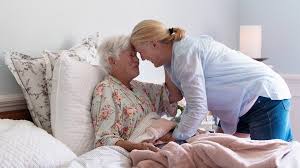The death at home movement gains steam during the pandemic
 Where a person dies does have an effect on funeral home operations. One simple effect you can see is that of two person removal teams to homes rather than a one-person removal being done at a hospital or nursing home where there is always facility staff help if needed. This recent article from the Associated Press and bylined out of Mission, Kansas, takes the side that the COVID-19 pandemic has increased the amount of deaths occurring under hospice care in homes.
Where a person dies does have an effect on funeral home operations. One simple effect you can see is that of two person removal teams to homes rather than a one-person removal being done at a hospital or nursing home where there is always facility staff help if needed. This recent article from the Associated Press and bylined out of Mission, Kansas, takes the side that the COVID-19 pandemic has increased the amount of deaths occurring under hospice care in homes.
It is interesting how societal customs change over time. When I started in the funeral business 40 years ago almost all deaths, even of those people who had been in nursing homes for some period of time, occurred in hospitals. My take on that is that is where the trained staffing such as nurses were located to take care of the pain medications and other issues that may occur with the near death patient. Back in that time period, many nursing home patients were actually transferred to hospitals in their last days.
At that time nursing homes just were not staffed up with the professional staff to handle these cases. Their position in that day was more of a long-term care living facility. And, hospice was just getting started. . .at least in my area of the country. Fast forward to today and you will find most nursing homes giving a level of care, that up until not too long ago, was only available in hospital settings. Couple that with our Medicare payment system and the goal is to move patients out of hospitals into lower cost levels of care, such as nursing homes and hospice settings, for pre-death palliative care.
The linked article from above talks about a funeral director and how he has noticed more and more deaths occurring at home during the pandemic. Many of these patients are those who are suffering from heart, lung, kidney, and other non-COVID maladies. However, if admitted to a hospital or nursing home the family comes under the restrictions of the COVID social visiting rules and in many cases, once a patient is admitted to the facility the family will never see them alive again.
What is interesting in this phenomena is that, even with the potential contagion of COVID-19, many families are choosing hospice at home even with COVID-19 patients. Here is an excerpt from the article on that issue:
“The separation part is really rough, rough rough. . . . My daughter went to the hospital and we saw her once through the glass when they put her on the ventilator, and then we never saw her again until after she died.”
Across the country, terminally ill patients — both with COVID-19 and other diseases — are making similar decisions and dying at home rather than face the terrifying scenario of saying farewell to loved ones behind glass or during video calls.
“What we are seeing with COVID is certainly patients want to stay at home,” said Judi Lund Person, the vice president for regulatory compliance at the National Hospice and Palliative Care Organization. “They don’t want to go to the hospital. They don’t want to go to a nursing home.”
This press release from the National Hospice and Palliative Care Organization (NHPCO) gives some statistics for the year 2017 on hospice care usage in the United States. It is interesting to note that they state that 48.2% of all deaths in the United States occurred under hospice care. Here are some other statistics from that press release:
- 14.1% of hospice patients are on hospice for more than 180 days
- 40.5% of hospice patients are on hospice for less than 14 days
- 45.4% of hospice patients are on hospice for between 14 and 180 days
- Utah has the highest percentage of hospice use at 59.4%
- Alaska has the least percentage of hospice use at 22.5%
In my opinion, there is little doubt that the home based hospice services will continue to grow and that patients will be referred to these services earlier and earlier in the pre-death diagnosis stage.

Tom Anderson
Funeral Director Daily
I’ve served as Chairman of the Board of two separate non-profit health care organizations that have offered hospice as part of our menu of services. The Knute Nelson organization and another organization in which Knute Nelson is a partner, Ethos Health Care. I don’t claim to be the biggest expert on hospice, however, I believe that hospice does have an effect on funeral home selection and could, someday, prove to be a competitor in the death care realm.
Many health care organizations in today’s world are horizontally integrated moving clients from wellness centers, to home health care, to senior living options, to assisted living, to eventually hospice care. On the early end, some have even gotten into a concierge service such as delivering groceries and mowing lawns. A goal is to gain clientele and clientele trust early in their above 55 year age and then move them along your line of services, as clients, for decades.
When you think of the time that a nurse spends in a hospice home. . . being there everyday for the hospice period. . . and the relationship that they build with the family, it is not so wild to think that maybe death care could eventually be added to the far end of the horizontal service platform of these health care providers.
Something like that has already been done in Australia where the non-profit Salvation Army organization has entered death care with its Salvos Funeral Services.
More news from the world of Death Care:
- Obituary: Richard “Rick” Alvin Resch. The Gonzalez Inquirer (TX)
- Outlook 2021: 4th Generation of McGonigle family serving area families. The Sharon Herald (PA)
- Police: Body left in coffin at former Silverthorne funeral home for months. Summit Daily (CO)
Enter your e-mail below t0 join the 1,920 others who receive Funeral Director Daily articles daily:





















In the UK, a hospice opened a funeral business.
http://archive.naplesnews.com/news/local/hope-hospice-pulls-funeral-home-application-ep-405307716-345761512.html/
https://www.st-margarets-hospice.org.uk/st-margarets-funerals
My concern is that hospice will make a run at the funeral profession and try to be an end-to-end services provider.